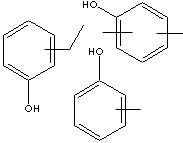PRODUCT IDENTIFICATION

TOXICITY
SMILES
CLASSIFICATION
Disinfectant, Fungicide, bactericide, Preservative,
EXTRA NOTES
PHYSICAL AND CHEMICAL PROPERTIES
SOLVENT SOLUBILITY
REFRACTIVE INDEX
EXTERNAL LINKS & GENERAL DESCRIPTION
http://oehha.ca.gov/
Major
Uses and Sources:Cresol compounds (mixtures of the ortho-, meta-
and para-isomers) can be obtained from coal tar and petroleum or
synthesized by sulfonation or oxidation of toluene (HSDB, 1995).
Crude cresol (commercial grade) contains approximately 20% o-cresol,
40% m-cresol, and 30% pcresol. Phenol and xylenols are present in
small amounts as contaminants. Cresylic acid compounds are called
cresol when the boiling point is below 204°C. Cresols have a
wide variety of uses including the manufacture of synthetic resins,
tricresyl phosphate, salicylaldehyde, coumarin, and herbicides.
Cresols also serve as components of degreasing compounds in textile
scouring and paintbrush cleaners as well as fumigants in photographic
developers and explosives. Cresols also function as antiseptics,
disinfectants, and parasiticides in veterinary medicine. An approximate
breakdown of cresol and cresylic acid use is 20% phenolic resins,
20% wire enamel solvents, 10% agricultural chemicals, 5% phosphate
esters, 5% disinfectants and cleaning compounds, 5% ore flotation,
and 25% miscellaneous and exports. Any combustion process, which
results in the generation of phenolic compounds (such as automobile
exhaust or coal, wood, or trash smoke), may be a potential source
of exposure to cresols. Cresols are also formed from the atmospheric
photooxidation of toluene. However, under normal conditions low
vapor pressure limits the inhalation hazard presented by cresols
(HSDB, 1995). The annual statewide industrial emissions from facilities
reporting under the Air Toxics Hot Spots Act in California based
on the most recent inventory were estimated to be 8407 pounds of
mixtures of cresols (cresylic acid), 3 pounds of m-cresol, and 3
pounds of o-cresol (CARB, 2000).
Local: Cresols are methyl substituted phenols at relative to the hydroxyl group, ortho-, meta-, and para-cresol. There are three structural isomers. The names of the three compounds indicate which of the hydrogens on the benzene ring portion of the molecule have been replaced. They are obtained from coal tar or petroleum as by-products in the fractional distillation and in coal gasification. They are also formed as by-products during the combustion of wood. The various isomers can be manufactured by the methylation of phenol, toluene sulfonation and alkaline hydrolysis, or the hydrolysis of 2-isopropyltoluene or alkaline chlorotoluene. Because the boiling points of these three compounds are nearly the same, a separation of a mixture of the three into its pure components is impractical. They are highly flammable and soluble in water, ethanol, ether, acetone and alkali hydroxides. The mixture of cresols obtained from coal tar is called cresylic acid, an important technical product used as a disinfectant and in the manufacture of resins and tricresyl phosphate. Cresylic acid also refs to the mixture of phenols containing varying amounts of xylenols, cresols, and other high-boiling fractions, but not more than 5 percent phenol. Commercial cresols are prepared in a wide range of grades and purities to meet the user's requirements. It is a liquid from clear to brown and is toxic to animals including human. It is corrosive and is a more powerful disinfectant and antiseptic than phenol. The primary use is for sterilizing as disinfectants and deodorizers, and pesticides. Its solution is used as household cleaners as a disinfectant. Creosote products are mixtures of many aromatic hydrocarbons including phenols and cresols. Creosote obtained from coal tar is poisonous and provides protection against fungi, shipworms, termites, and psoriasis. It is used chiefly as a wood preservative, e.g., in wooden poles, railroad ties, and timber. They are also used as animal and bird repellents. Animals may suffer skin irritation or ulceration from creosote treated wood. Coal tar creosote and its derivatives are the most widely used wood preservatives. Wood tar creosote is a mixture of chiefly guaiacol, creosols and other phenolic compounds obtained from wood tar (mainly beech) by distillation between 203 and 220 C. It is insoluble in water, soluble in methanol, acetone. It is used as an external antiseptic, expectorant, gastric sedative, deodorant, and as an antiseptic parasiticide veterinary use in the form of creosote carbonate. It is used in the synthesis of pharmaceuticals and vanillin. Each cresols are used as solvents or disinfectants and as useful as raw materials for various chemical products including;
- Antiseptics, disinfectants
- Fragrances, deodorizing, odor-enhancer
- Resins (phenol-formaldehyde, phenolic, and epoxy) and their additives
- Phosphate esters (plasticizers)
- Herbicides and pharmaceuticals
- Rubber and plastic antioxidants
- Dyes and pigments
- Household cleaners and automotive degreasers
- Solvent and paints
- Lubricating oils, gasoline additives
- Adhesives
- Fiber and wood preservatives
- UV- absorbers and photographic chemicals
- Ore flotation agents
Cresols undergo electrophilic substitution reactions such as chlorination, bromination, sulfonation and nitration at the vacant position. They also undergo condensation reactions with aldehydes, ketones or dienes. O-cresol is a starting material for the synthesis of herbicides such as 4,6-dinitro-o-cresol (DNOC) and 2-methyl-4-chlorophenoxyacetic acid (MCPA). Meta-cresol is used in the manufacture of explosives. Meta and para-cresol are used in phenol-formaldehyde resins and are converted to tricresyl phosphate used as a plasticizer and gasoline additive and antioxidants such as di-tert-butylcresols (BHT). Ortho- and para-cresols are used in the production of lubricating oils and motor fuels.
TAR GRADE
APPEARANCE
SPECIFIC GRAVITY
1.0% max
15 - 25%
22 - 35%
0.5% max
ISOMER GRADE
APPEARANCE
80.0% min
5.0% max
1.0% max
0.5% max
0.5% max